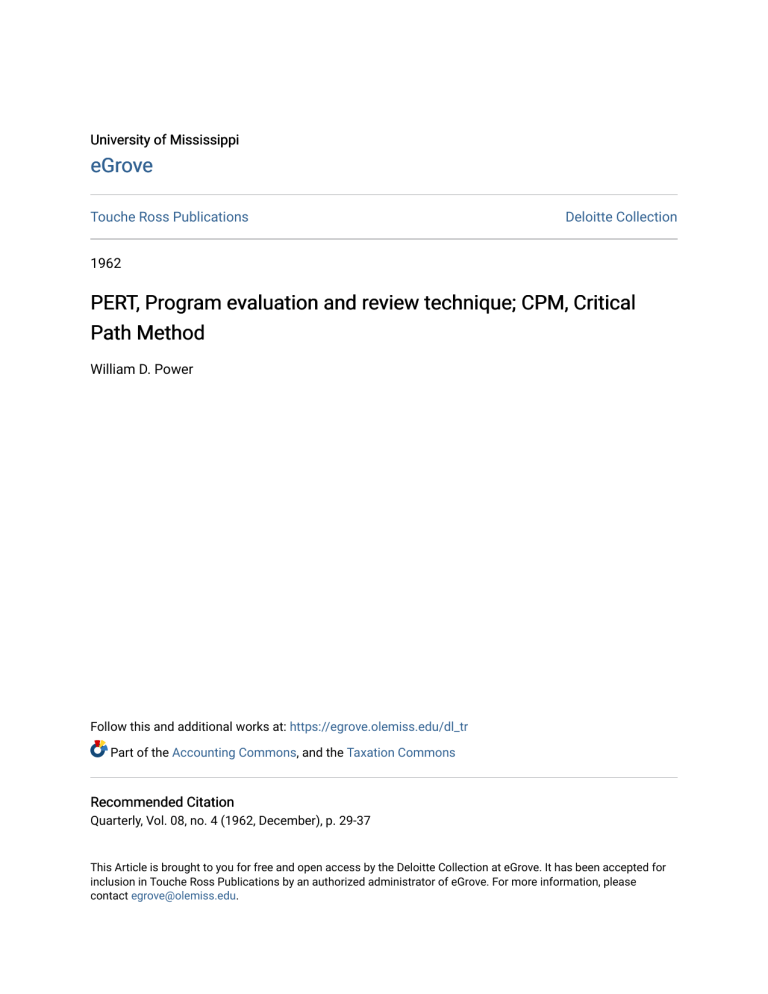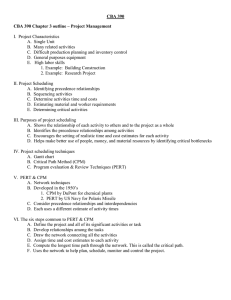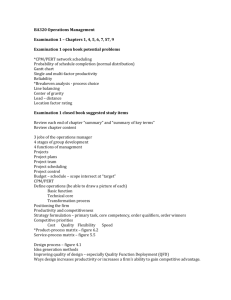PERT Program evaluation and review technique; CPM Critical Path
advertisement

University of Mississippi eGrove Touche Ross Publications Deloitte Collection 1962 PERT, Program evaluation and review technique; CPM, Critical Path Method William D. Power Follow this and additional works at: https://egrove.olemiss.edu/dl_tr Part of the Accounting Commons, and the Taxation Commons Recommended Citation Quarterly, Vol. 08, no. 4 (1962, December), p. 29-37 This Article is brought to you for free and open access by the Deloitte Collection at eGrove. It has been accepted for inclusion in Touche Ross Publications by an authorized administrator of eGrove. For more information, please contact egrove@olemiss.edu. PERT Program Evaluation and Review Technique M.-uch has been written recently about PERT and its companion CPM. It is difficult to pick up a business or technical publication nowadays without finding an article on the subject. Lately, we have also been hearing about PERT/COST. What is PERT? Why is it such a popular subject now? And how does it affect us in Touche, Ross, Bailey & Smart. PERT and CPM are management devices which deal with the planning, scheduling, and controlling of complicated programs where many inter-related events must take place in a given sequence in order to produce a particular end result. An excellent example of such a program is the design and construction of a space craft or a missile. But examples with which we are more familiar in everyday business are construction LEGEND An oval represents a completed event. An arrow represents an activity, the number refers to the units of time (days in this case) required to complete it. _ The heavy arrows represent the criti"*^""" cal path — the longest path through the network. n [ /DRAWINGS^'' ^ f COMPLETED ]~ CPM Critical Path Method by William D. Power, Management Services Central Staff of buildings, ships, automobiles, etc., mining operations, maintenance, moving of large facilities such as manufacturing plants, and installation of electronic computer systems. A more specialized application is in the planning of complicated surgical operations. PERT (the term will include CPM for the purpose of this article) has gained wide acceptance and usage because it represents an advance over previously available planning and scheduling methods (such as bar charting). The technique offers two significant advantages. First, it presents a graphic representation of the inter-relation between and among events and activities in a program. The resulting chart is called a network and looks something like the figure below. The second advantage A PERT NETWORK is that it determines and shows a critical path through the network which is made up of a series of specific events which cannot be delayed without delaying the entire program. Stated another way: When an event on the critical path falls behind schedule, it can be expected that the end result will fall behind by a like time. An event off the critical path would not have the same direct effect on the completion of the over-all program. In the chart, the critical path is indicated by the heavy line. More on that later. PERT was developed in 1958 at the request of the Defense Department when a more effective scheduling and control procedure was needed for research and development projects for weapons systems. Its use was then carried into many other aspects of Defense Department procurement and has been so successful that defense contractors are required now to use PERT in the scheduling of production for many military contracts. Private industry has adopted the technique in connection with nondefense production and has worked toward refinement of the method and inclusion of cost effects. Our firm has given much attention to PERT as a management services tool. At the present time, our Management Services Central Staff is "PERTing" the moving of the production facilities of an Italian metal fabricating plant to a new location. The objective is to plan and control the construction of a new plant and the transfer of operations with a minimum loss of production. At the University of Minnesota, Dr. Gordon Davis (formerly of Touche, Ross, Bailey & Smart) is working under a research grant from our firm to examine the applicability of PERT to accounting systems and to the conduct of audit programs. This work is being carried out in cooperation with our Minneapolis Office. Our own internal research program includes work on the application of PERT techniques to the installation of computer systems in specific industry applications and on the general use of the method in various business programs. It seems inevitable that our management services efforts will bring us more and more in contact with clients who will need assistance in the use of PERT techniques. While the larger client firms will probably develop in-house capabilities in PERT, many smaller clients will have to rely on outside help. They will need PERT either to satisfy government requirements when they are performing as subcontractors or to increase the effectiveness of their own commercial operations. Members of our firm should, therefore, have a knowledge of the method so that they can 30 THE QUARTERLY recognize potential applications and offer the services of our qualified Management Services people. HOW PERT WORKS I. The Network Method Network analysis methods have general applicability to complex programs where scheduling and control of many inter-related functions are essential to their successful completion. Such programs are typified by the following characteristics: 1. A definite objective exists which must be accomplished at a given point of time or in the shortest possible time. 2. The objective can be assigned a specific completion date. 3. The steps which must be performed to achieve the objective are identifiable as functions which can be carried on independently of each other. 4. The sequence in which the steps must be performed can be determined. 5. The time required to perform each step can be estimated with reasonable accuracy. 6. The completion of specific steps can be affected by shifting effort and resources within the program. A PERT approach to a program would follow a sequence something like this: 1. Define objective. 2. Establish desired completion date. 3. Identify all steps which must be performed. 4. Establish sequence of steps in relation to one another. 5. Estimate time required for each step. 6. Prepare network chart. 7. Determine critical path. 8. Assign resources to functions. 9. Report progress. 10. Recompute critical path and reassign resources as necessary to achieve Completion date. DECEMBER 1962 ( Continued on next page) 31 II. The Network Chart The preparation, understanding, and interpretation of the network chart requires a knowledge of a few symbols and rules, and some network terminology. First, the term "network" refers to the graphic presentation of the program as illustrated in the chart. The ovals on the chart signify "events." An event represents the accomplishment of some specific part of the program such as the availability of a part, the making of a decision, or the release of funds. An event is considered to take place at a specific point in time, but it does not of itself consume time. Time in the network presentation is connected with "activities" which are represented by arrows. An activity can be a process, a job, a procurement cycle, etc. It is the time-consuming element necessary to proceed from one event to another. The direction of the arrow is also significant since it shows the interrelationship between events — the sequence in which events must occur. More than one activity (arrow) may be required to complete an event, and the event cannot be considered to have occurred until all activities leading to it are completed. Nor can an activity be started until all activities preceding it are completed. (An inspection of a part cannot take place, for example, until the part is assembled.) Notice in the chart that some activities take place in series while others proceed in parallel. These requirements may seem somewhat obvious and artificial at first, but they are intended to provide clear cut decision rules and understanding in the treatment of various situations. Their purpose becomes more evident as one becomes increasingly involved in the network development. Here are a few more significant rules about the network structure: 1. Only one arrow can represent an activity. 2. Arrow length has no significance. 3. Arrow direction is significant only in regard to the beginning of an activity (tail) and the end of an activity (head). It has no vectoral significance in connection with the physical position of event ovals on the chart. 4. All activities must begin and end with an event. 5. Only arrows with common junctions are inter-related. 6. If one event takes precedence over another, but no activities connect them, they are connected by a dummy arrow (broken line). A dummy arrow has no time associated with it. (See chart.) 32 THE QUARTERLY 7. The number assigned to an event is merely for the purpose of identification. It is not intended to indicate its sequence in the program. Sequence is indicated by the flow of arrows. III. Time Estimates Once the network has been constructed showing the events and activities in proper sequence and relation, it is necessary to make the time estimates which will affect the subsequent determination of the critical path (see below). Time estimates to complete each activity are made on the basis of the shortest practical time, the most likely time, and the longest or most pessimistic time. This method permits the construction of a probability distribution considering the estimated times for all activities in the program. While the highest probability exists that an activity will be completed in an actual time which is close to the "most likely" time, it is possible that it may move toward one of the extreme estimates. The ability to consider such an eventuality is important in determining the probability of meeting the over-all schedule. The use of multiple time estimates also has a psychological effect on line operators who are required to make the estimates. It tends to minimize "padding" of estimates in order to provide "insurance" since it provides for high and low extremes.1 In the chart numbers on the arrows show a single time estimate (in days) for the sake of simplicity. IV. Critical Path At this point, it is possible to determine the "critical path" through the network. The critical path is the longest path (in time) from beginning to end of the program based on the time estimates for activities — it shows the minimum time required to complete it. In the chart the sum of 38 days along the critical path is the largest in the network. This concept is important because it is the key to control and adjustment of the resources and effort which are necessary to complete the project. When it becomes necessary to apply pressure to shorten the time, in order to speed up completion of the project or make up for unexpected delays, it is essential that such pressure be applied to the critical path. Since a relatively small number of the total events in a program (10-15%) are likely to fall on the critical path, it would be wasteful to attempt to apply pressure to all the activities in the entire program — 1. A major difference between PERT and CPM lies in the treatment of time estimates. CPM uses a single estimate for each activity and does not consider the probability aspect. CPM also provides more readily for the inclusion of cost effects. DECEMBER 1962 33 that is, to speed up everything. It can be seen by examining a network that some delays in non-critical activities can be tolerated without causing a delay in the over-all project time. The opposite is true of activities on the critical path. As was stated earlier, a delay in an activity on the critical path will cause a like delay in the completion of the over-all project. The term "slack" is used to describe the amount of time by which activities can be delayed without affecting the over-all completion date. It might be concluded from the foregoing that a speed-up in a critical path activity would result in a corresponding shortening of the over-all project time. This is not necessarily true since the speed-up may alter the critical path. The critical path should not, then, be considered fixed. It can shift as resources are applied to various segments of the program. The PERT method is used in developing the plan for a program and exposes clearly the critical requirements for assignment of resources at the outset. As the program proceeds, reports on actual accomplishment are fed back into the network, and determinations are made of what revisions, if any, must be made in order to prevent falling behind schedule. When revisions are required, proposals for the re-allocation of resources can be evaluated in terms of their effect on the critical path of the program. Use of Computers While the calculations for smaller programs can be done manually, it can be readily appreciated that the network evaluation and determination of a critical path in a program containing many thousands of events and activities can be a highly complex and time-consuming task. For this reason, electronic computers play an important part in PERT methods. Most computer manufacturers offer prepared programs for their equipment which will accept information describing activities, events, sequences, time estimates, etc., and calculate starting times, slack, and critical paths. The results of the computations are printed out as reports for use by project managers in scheduling, assigning resources, modifying operations, and controlling the progress of the program. Application of PERT Earlier in this article mention was made of the PERT work we are doing in Italy in connection with the construction of a new metal fabricating plant and the transfer of operations from the old plant. In this engagement, networks have been constructed to schedule and control 34 THE QUARTERLY three major elements of the project: machines, personnel, and construction. The machines network contains all of the activities and events necessary for the orderly movement of existing machines as well as the procurement of new ones where necessary. Machines will be provided at the new facility according to product group so that fabrication of certain items can be commenced prior to the completion of the entire plant. The personnel network contains the factors related to the transfer, hiring, and training of workers who will operate the new facility. It also includes such considerations as housing requirements and providing for an enlarged work force to handle expanding production. The construction network treats the activities related to the design and erection of the new buildings and permanent plant facilities. This program begins with architectural work and includes selection of contractors as well as the actual physical construction. The network also considers such factors as the provision of services — light, heat, power, water, etc. In projects of this type which are separated into distinct parts, each comprising a large number of activities and each with its own network, it is necessary to provide a means for bringing all the parts together at an appropriate point. This "interface" problem, as it is called, is one of the most difficult and complex to solve in the PERT procedure. IBM 1401 and 7070 computers are being used to perform the multitude of calculations required. Typical outputs of computer processing are: 1. Reports showing all activities with their respective start times, duration, completion dates, slacks, and criticalness. 2. Report of all activities on the critical path. 3. Report of activities with "negative slack." These are activities which cannot be finished by the scheduled completion date under present circumstances. 4. Report of completed activities. PERT/COST PERT/COST has developed as a logical extension of the basic PERT system, which is sometimes referred to as PERT/TIME for comparison. In applying the cost concept, an effort is made to associate costs with specific activities or groups of activities not only for purposes of budgetary DECEMBER 1962 35 control, but to evaluate the economics of alternate moves in the application of resources to various parts of a program. It enables management to trade off cost against time or vice versa under appropriate circumstances. Collecting costs in relation to groups of activities within the network requires that accounts be set up for that purpose so that the reporting system can reflect performance within the program rather than by organizational or functional grouping such as manufacturing, design, or engineering. The project is broken into manageable sectors which are related to the completion of specific tasks. This breakdown begins with major segments of the program which are identified with the completion of so-called "end items." An example of an end item would be a major component of manufacture deliverable as a unit, such as an engine in automobile or aircraft production. The end item is further separated into "divisions" which are in turn divided into "work packages." Work packages usually constitute the lowest level of subdivision of work for the purpose of cost collection. Normally, a work package would contain a number of activities which would generate costs, but collecting costs by individual activity is generally found to be finer than is required. Examples of work packages in the engine example above might be engineering, manufacturing, testing, etc. Note that work package identification can correspond closely to organizational or functional identification. However, the costs considered in PERT/COST would be only those related to a specific project rather than to the operation of an entire department (engineering, for example). Cost data are included as a part of the computer input in the PERT system and add a valuable dimension to the significance of output reports. It becomes possible not only to evaluate the status of a program in terms of accomplishment against time, but to determine the degree to which budgetary requirements are being met. Significant management information is also provided in relation to exceptions — accomplishment greater or less than that scheduled. A portion of the program may be found to be running ahead of schedule while at the same time developing a cost overrun (or vice versa). Reference to the related activities in the network and to the effect on critical path events will enable management to make a sound decision regarding the reallocation of funds to bring the system into balance. It seems clear that PERT is a dynamic, expanding management tool which should receive attention throughout our firm — not only from the management services group, but from our accounting staff as well. 36 THE QUARTERLY The following government publications are suggested as reference material for further study of PERT: 1. PERT Instruction Manual and Systems and Procedures for the Program Evaluation System. Department of the Navy, Bureau of Naval Weapons, Special Projects Office; GPO Catalog No. D217.14: P9/2, Washington: Government Printing Office, 1960. 2. PERT Summary Report, Phase I., Department of the Navy, Bureau of Naval Weapons, Special Projects Office; GPO Catalog No. D217.2: P94/958, Washington: Government Printing Office, 1960. 3. PERT Summary Report, Phase II., Department of the Navy, Bureau of Naval Weapons, Special Projects Office; GPO Catalog No. D217.2: P94/958-2, Washington: Government Printing Office, 1961. 4. PERT Cost, Department of Defense and National Aeronautics and Space Administration, GPO Catalog No. 1962 0-646214, Government Printing Office, 1962. 5. The PERT/COST System for Integrated Project Management, Special Projects Office, Navy Department, GPO Catalog No. 1962 0-630858, U. S. Government Printing Office, 1962. About the Author . . . D. POWER is the Administrative Manager in our Management Services Central Staff. Born in Bridgeport, Connecticut, Mr. Power took his B.B.A. at the University of Oklahoma, where he was a member of Beta Gamma Sigma, business honorary fraternity. Mr. Power spent 13 years in the Air Force, resigning in 1954 with the rank of Major. He was formerly associated with Remington Rand UNIVAC as special representative for Retail Industry. WILLIAM DECEMBER 1962 h 37





